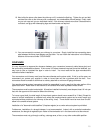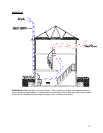
HEATING
Once you have obtained a good bed of embers you should reload the unit. In order to do so, open the air
control completely for a few seconds prior to opening the stove door. Then, proceed by opening the door
very slowly. Open it by one or two inches for 5 to 10 seconds before opening it completely. This will increase
the draft and will eliminate the smoke, which is stagnant in a state of slow combustion. Then, bring the red
embers to the front of the stove and reload the unit. Use only the quantity of wood required depending on
the circumstances; for example, in severe cold weather, load the stove to maximum. During milder
temperatures, the stove should be only half loaded.
CAUTION : DO NOT PLACE LOGS TOO CLOSE TO
THE GLASS OR THE DOOR. IF LOGS ARE TOO CLOSE TO THE GLASS OR THE DOOR, THEY MAY
FALL WHEN YOU OPEN THE DOOR. FURTHERMORE, THE LOGS THAT ARE TOO CLOSE MAY
DAMAGE THE GLASS IF YOU SHUT THE DOOR TO HARD.
When possible, we recommend that you operate the stove with a wood load approximately equivalent to the
height of the fire bricks. If you constantly load the stove above the fire bricks, you may damage the firebox
and cause the paint to whiten.
In the case of the FX 3000, the exterior air intake and combustion supply control is located underneath the
door. It uses a push\pull technique. The air intake is opened when the control knob is completely pulled
toward the front and closed when it is pushed toward the back.
It is extremely important that you use your stove in such a way that you do not lower the temperature of the
combustion gases inside the chimney too much. For this purpose, we strongly recommend that you install a
Drolet chimney thermometer on your exhaust pipe, approximately 18" above the stove. Contact your Drolet
dealer in order to buy one. This thermometer will indicate the temperature of your exhaust gases inside the
exhaust system. The ideal temperature range is indicated on the thermometer. If temperature is too low, the
build-up of creosote is promoted while if temperature is too high, heat is wasted since too large a quantity is
emitted into the atmosphere.
In summary, it is very easy to operate your wood stove and you can prevent all potential problems by
following these recommendations:
1) Select a stove of adequate size: selecting a stove that is too big for the area to be heated is a
common mistake;
2) Follow the installation standards scrupulously and respect the clearances to combustible material;
3) Burn only dried wood, that is, with a maximum 20% humidity content;
4) Install a chimney thermometer on your stove pipe, 18" (457 mm) above the stove, and maintain the
temperature of your exhaust gases between 250°F and 475°F.
Keep in mind that the most difficult months for wood heating are October and November. Indeed, during this
period, the atmosphere is often very heavy and humid, and may hinder the chimney draft. Moreover, the
wood is often too damp, since it has not had a sufficient drying period, or it has been stored outside in the
rain. Combustion problems may then occur.
Important:
It is important to note that wood combustion consumes ambient oxygen in the room. In the case of negative
pressure, it is a good idea to allow for a fresh air intake in the room, either by opening a window slightly or by
installing a fresh air intake system on an outside wall.
21


















